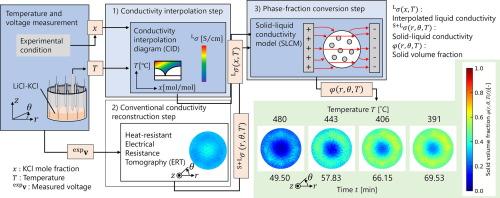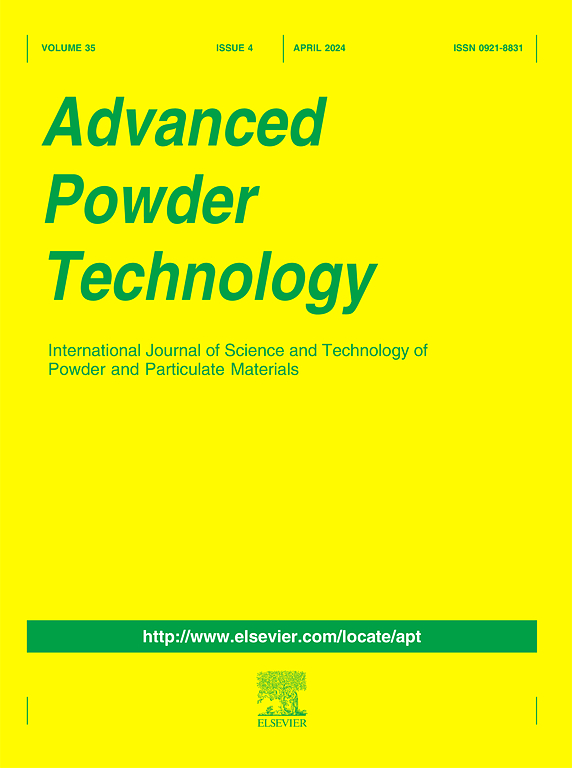利用热补偿电阻断层成像技术(tcERT)观察锂-氯化钾熔盐凝固过程中固体体积分数的时空分布情况
IF 4.2
2区 工程技术
Q2 ENGINEERING, CHEMICAL
引用次数: 0
摘要
热补偿电阻断层扫描(tcERT)实现了锂-氯化钾熔盐凝固过程中固体体积分数时空分布的可视化。tcERT 包括三个步骤:1)电导率插值步骤;2)常规电导率重建步骤;3)相分数转换步骤。第一步,通过电导率插值图(CID)定义氯化钾分子分数 x 和测量温度 T 条件下的液体电导率 Lσ(x,T)。第二步,凝固过程中的电导率由传统的耐热 ERT 定义为重建的固体和液体电导率 S+Lσ(r,θ,T(t))。根据这两个步骤,固液传导模型 (SLCM) 计算出凝固体积分数 φ(r,θ,T(t)),该模型通过参考 Lσ(x,T)将 S+Lσ(r,θ,T(t)) 转换为 φ(r,θ,T(t))。在初始温度 0T= 700 ℃、冷却速度 γ= 4.44 ℃/分钟的条件下,在带有铂丝电极的坩埚中对 85 mol % LiCl-15 mol % KCl 的成分进行了 tcERT 试验。结果表明,φ(r,θ,T(t))分布不均匀且不稳定,空间均值〈φ〉(T(t))的最大相对误差ζ= 0.763。本文章由计算机程序翻译,如有差异,请以英文原文为准。

Spatiotemporal distribution visualization of solid volume fraction during LiCl-KCl molten salt solidification by thermal-compensated electrical resistance tomography (tcERT)
Spatiotemporal distribution visualization of solid volume fraction during LiCl-KCl molten salt solidification has been visualized by thermal-compensated electrical resistance tomography (tcERT). The tcERT consists of three steps which are 1) conductivity interpolation step, 2) conventional conductivity reconstruction step, and 3) phase-fraction conversion step. In the first step, the liquid electrical conductivity under mole fraction of KCl and measured temperature is defined by conductivity interpolation diagram (CID). In the second step, the electrical conductivity during solidification is defined by the conventional heat-resistant ERT as the reconstructed solid and liquid conductivity . From both steps, the solidification volume fraction is calculated by the solid–liquid conductivity model (SLCM) which converts into by referring to . The tcERT was applied to a composition of 85 mol % LiCl–15 mol % KCl in a crucible with platinum-wire electrodes under the initial temperature 700 °C and at cooling rate 4.44 °C/min. As the results, inhomogeneous and unsteady distributions were precisely visualized with a maximum relative error 0.763 of space-mean , where the inhomogeneity refers to the spatial gradient perpendicular to the crucible wall, and the fluctuation describes the transition from the nucleation region to the crystal growth region.
求助全文
通过发布文献求助,成功后即可免费获取论文全文。
去求助
来源期刊

Advanced Powder Technology
工程技术-工程:化工
CiteScore
9.50
自引率
7.70%
发文量
424
审稿时长
55 days
期刊介绍:
The aim of Advanced Powder Technology is to meet the demand for an international journal that integrates all aspects of science and technology research on powder and particulate materials. The journal fulfills this purpose by publishing original research papers, rapid communications, reviews, and translated articles by prominent researchers worldwide.
The editorial work of Advanced Powder Technology, which was founded as the International Journal of the Society of Powder Technology, Japan, is now shared by distinguished board members, who operate in a unique framework designed to respond to the increasing global demand for articles on not only powder and particles, but also on various materials produced from them.
Advanced Powder Technology covers various areas, but a discussion of powder and particles is required in articles. Topics include: Production of powder and particulate materials in gases and liquids(nanoparticles, fine ceramics, pharmaceuticals, novel functional materials, etc.); Aerosol and colloidal processing; Powder and particle characterization; Dynamics and phenomena; Calculation and simulation (CFD, DEM, Monte Carlo method, population balance, etc.); Measurement and control of powder processes; Particle modification; Comminution; Powder handling and operations (storage, transport, granulation, separation, fluidization, etc.)
 求助内容:
求助内容: 应助结果提醒方式:
应助结果提醒方式:


